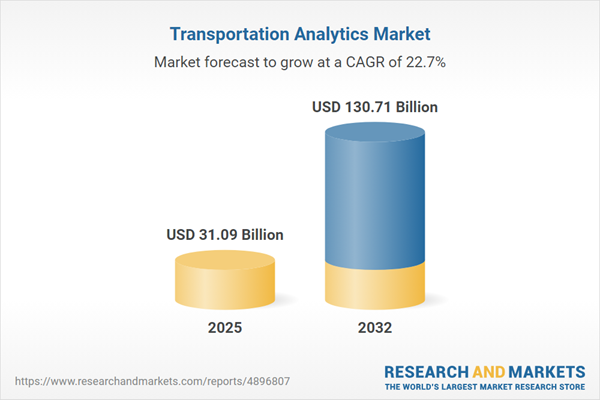Speak directly to the analyst to clarify any post sales queries you may have.
Transportation analytics empower senior decision-makers to optimize logistics performance and strengthen compliance in today's dynamic operating environment. As organizations pursue digital transformation and respond to sustainability requirements, these analytics solutions help ensure adaptive, efficient, and resilient logistics operations.
Market Snapshot: Transportation Analytics Market Overview
The transportation analytics market is experiencing substantial growth, valued at USD 25.41 billion in 2024 and projected to reach USD 31.09 billion by 2025, ultimately estimated at USD 130.71 billion by 2032. The market exhibits a robust compound annual growth rate (CAGR) of 22.71%.
This expansion reflects strong investments in digital transformation, adoption of sustainable logistics practices, and heightened focus on regulatory compliance frameworks. The increasing complexity of global supply chains, combined with fluctuating supply and demand challenges, underscore the necessity of robust analytics platforms. These platforms provide the intelligence required for leadership to identify risks, ensure continuity, and facilitate rapid, evidence-based responses across diverse transportation modes and regions.Scope & Segmentation of the Transportation Analytics Market
This report provides actionable insights for senior leaders, emphasizing how strategic analytics adoption drives organizational performance across multiple logistics domains and operational contexts. It covers areas where transportation analytics deliver measurable impact:
- Transport Mode: Analyzes analytics applications across air cargo, passenger airlines, rail, road freight, passenger vehicles, inland waterways, and maritime shipping. Each mode encounters unique operational complexities and regulatory obligations that analytics address through specialized solutions.
- Propulsion Type: Reviews analytics approaches for conventional fuel systems and alternative propulsion, including battery-electric, advanced powertrains, and fuel cell technologies. These insights support sustainable investment and cost management strategies.
- Application: Examines use cases such as asset and shipment tracking, predictive maintenance, route optimization, infrastructure management, and improvements in passenger experience via automation and enhanced visibility.
- Technology: Evaluates how artificial intelligence, machine learning, big data analytics, predictive modeling, deep learning, and telematics are advancing operational safety, compliance, and real-time responsiveness in transportation environments.
- Deployment Type: Assesses the scalability and security of cloud-based versus on-premise analytics, focusing on compatibility with global IT architectures and adherence to complex compliance requirements.
- Regional Coverage: Details adoption patterns in the Americas, Europe, the Middle East & Africa, and Asia-Pacific, accounting for regional differences in infrastructure investment, regulatory frameworks, and digital transformation maturity.
- Company Insights: Profiles industry leaders such as International Business Machines Corporation, SAP SE, Microsoft Corporation, and Oracle Corporation, illustrating best practices through documented analytics deployments and results.
Key Takeaways for Senior Decision-Makers
- Transportation analytics support proactive risk mitigation, enabling faster adaptation to evolving market conditions and supply chain changes.
- Integration of advanced analytics tools, including artificial intelligence, improves asset management by detecting patterns and predicting potential operational disruptions before they escalate.
- Analytics foster the transition to sustainable and electrified transportation models, supporting organizational goals around environmental responsibility and long-term efficiency.
- Customization of analytics solutions allows alignment with region-specific regulations, reducing both compliance risk and administrative complexity.
- Collaboration with analytics vendors and consultancies enhances digital transformation, supporting operational resilience and future-proofing logistics infrastructure.
- Analytics-driven insights inform agile strategic planning, providing a strong basis for maintaining competitive advantage in the face of shifting industry challenges.
Tariff Impact: Effects of U.S. Trade Measures on the Transportation Analytics Ecosystem
Ongoing changes in U.S. trade tariffs prompt organizations to rethink sourcing and logistics strategy throughout the transportation analytics value chain. Advanced analytics support scenario modeling, allowing businesses to respond effectively to evolving trade requirements and enhance supply chain resilience against regulatory or market disruptions.
Methodology & Data Sources
Findings are grounded in interviews with senior executives, comprehensive reviews of secondary research, and rigorous quantitative modeling. Insights are informed by expert input and regulatory assessments, ensuring the analysis addresses the realities faced by decision-makers in the transportation analytics sector.
Why This Report Matters: Transportation Analytics Market
- Enables executive teams to anticipate and address regulatory and market shifts in the transportation analytics landscape.
- Supports effective deployment of analytics tools, resulting in stronger operational reliability and streamlined data-driven decision-making.
- Benchmarks organizational digital transformation progress against industry standards to maximize returns on analytics investment initiatives.
Conclusion
Transportation analytics deliver the intelligence needed for organizations to navigate logistics challenges, drive sustainable growth, and maintain agility amid ongoing global change. Senior leaders can act with confidence using insights from this report to guide strategic decisions.
Additional Product Information:
- Purchase of this report includes 1 year online access with quarterly updates.
- This report can be updated on request. Please contact our Customer Experience team using the Ask a Question widget on our website.
Table of Contents
3. Executive Summary
4. Market Overview
7. Cumulative Impact of Artificial Intelligence 2025
Companies Mentioned
The companies profiled in this Transportation Analytics market report include:- International Business Machines Corporation
- Oracle Corporation
- SAP SE
- Microsoft Corporation
- SAS Institute Inc.
- Cisco Systems, Inc.
- Trimble Inc.
- TomTom N.V.
- HERE Global B.V.
- INRIX, Inc.
Table Information
| Report Attribute | Details |
|---|---|
| No. of Pages | 185 |
| Published | October 2025 |
| Forecast Period | 2025 - 2032 |
| Estimated Market Value ( USD | $ 31.09 Billion |
| Forecasted Market Value ( USD | $ 130.71 Billion |
| Compound Annual Growth Rate | 22.7% |
| Regions Covered | Global |
| No. of Companies Mentioned | 11 |









